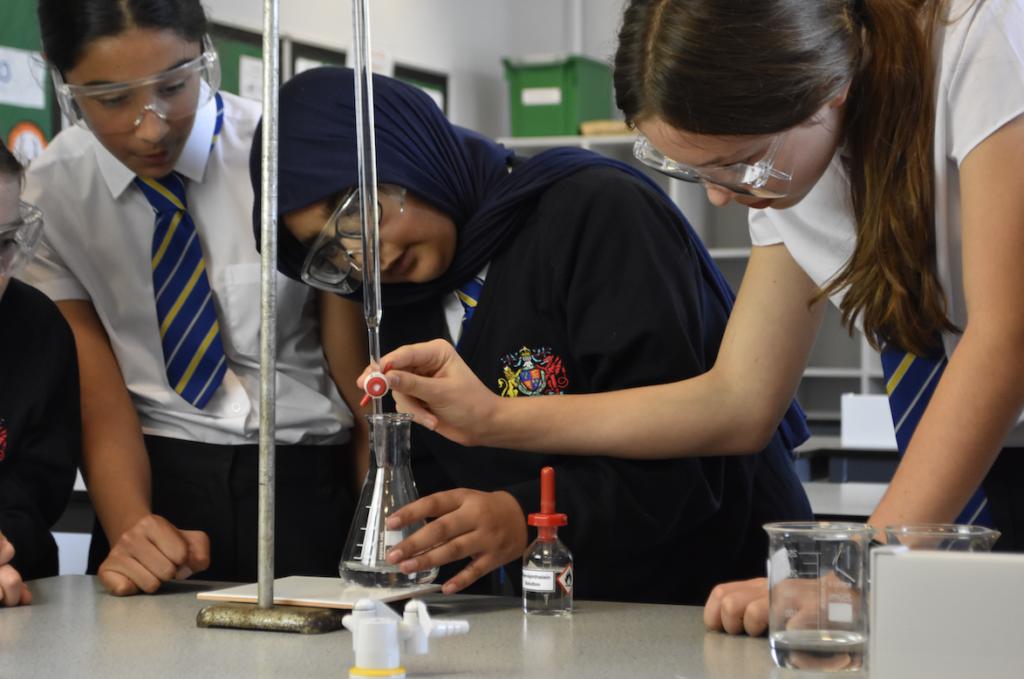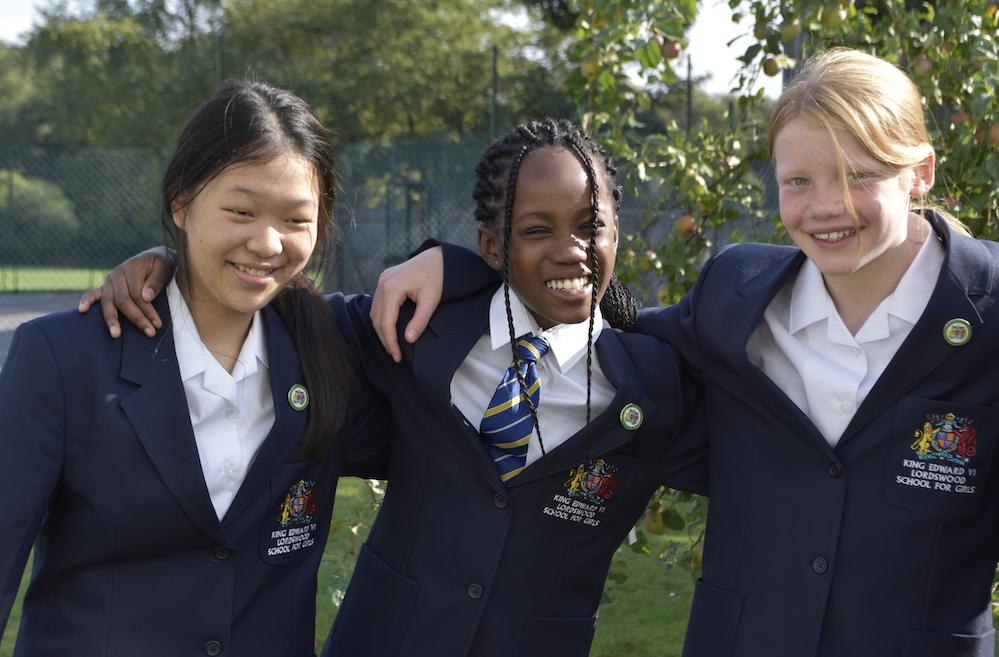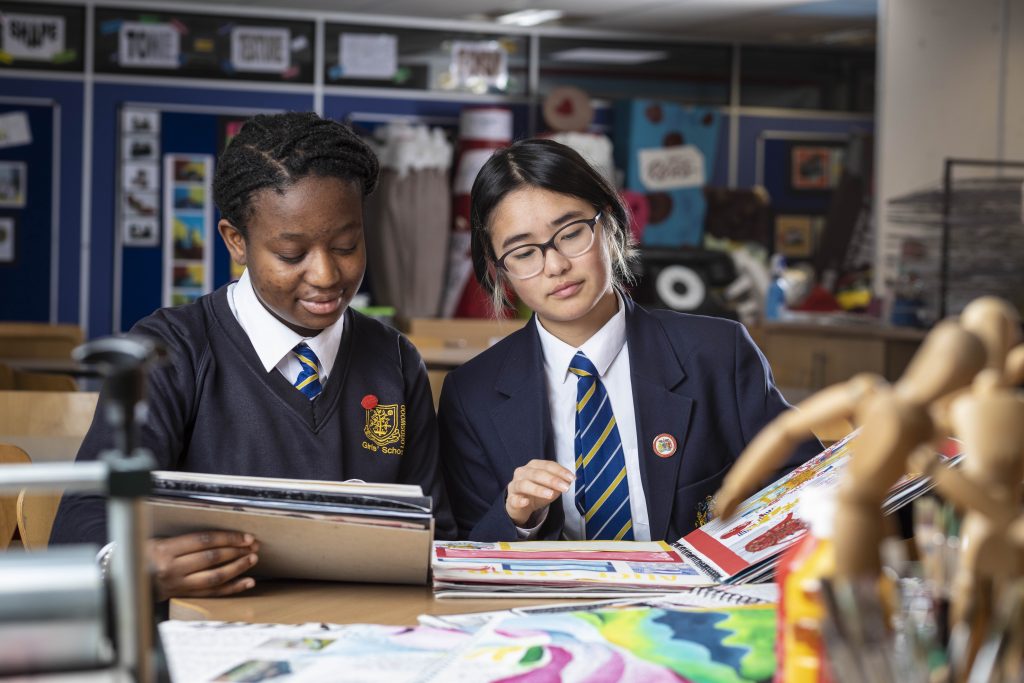Art, Craft & Design
This course allows students to explore and experiment with a wide range of art techniques and media. Students will be given two project themes over the two years for which they will have to produce a sketchbook and final piece.
During the course, students will be shown how to draw and to use printing techniques, paint, photography and digital media. Students will then be able to choose which media or combination of media they wish to use to produce their final pieces. All of the work produced for these projects will be submitted in a portfolio which equates to 60% of the overall marks. In addition to this portfolio, students are also given a selection of questions/ themes that have been written by the examination board. They will have a set number of weeks to produce a sketchbook based on their chosen question/ theme and then a ten hour examination during which they will have to make the final piece.
The examination unit will make up the other 40% of the overall grade.
Year 10
Full year project: Unit 1; Everyday objects
This is a teacher led project which focuses on the development of artistic skills across a range of media. Students will be introduced to key pieces of work by artists including Jim Golden, Jan Groover, Henrik Bonnevier, Sir Michael Craig Martin, Roy Lichtenstein and Alice Skipp. Students will be shown methods of engaging with and responding to the artists’ work using written analysis, photography, drawing skills, printmaking techniques, painting methods and digital software. Students will create a range of work which directly responds to that of the artist until towards the end of the project where they begin to combine techniques and styles to create original outcomes.
Year 11
Autumn Term
Unit 1; Self selected project
Students will select their own starting point for this project. This is an opportunity for students to specialise in a technique that they enjoy most or wish to spend more time developing and to focus on a theme that they are passionate about. Projects should include written analysis of artists’ work, first hand recordings and experimental work using materials of their choice.
Spring Term
Externally set question (Unit 2, examination project)
Students receive their Externally set question examination paper on 1st January or as close to that date as possible. They will choose one starting point and create a sketchbook or series of design sheets that demonstrate their exploration of the chosen starting point. Projects should include written analysis of artists’ work, first hand recordings and experimental work with artistic materials and techniques.
Summer Term
Externally set question (Unit 2, examination project)
The final 10 hour examination usually takes place during the first week of May. During the examination time students will create a final outcome for their externally set question. Examinations take place in the art rooms.
Assessment at Key stage 4
Artwork produced for the GCSE course can only be fully assessed when a unit is complete. However, students are provided with feedback verbally in lessons throughout the course and year 10 students are provided with written targets regularly on a task list in order to improve key pieces of work throughout the Everyday objects project. At the end of the Everyday Objects project the work will be assessed using AQA assessment criteria and a mark out of 96 will be shared with students on a personalised sheet together with a list of tasks that will help improve the work. Students will then have the opportunity to improve this work whilst they work on their second project.
The main deadlines are as follows;
Year 10 Summer Term: project 1 deadline, to be assessed as part of Unit 1.
Year 11 end of Autumn Term: Project 2 deadline, to be assessed as part of Unit 1.
Spring Term: Examination paper (Unit 2; Externally set question) preparatory period plus 10 hour examination time.
All units are internally assessed and a sample will be externally moderated.
How can parents help support their child’s learning?
Encouraging your daughter to draw, photograph and collect relevant imagery as projects progress will help her to improve her observational skills. Fostering a love of learning about art by visiting local galleries or taking part in community workshops is a great way of accessing art outside of school. Being able to select information from the internet is also important and is something that may need reinforcing at home if you notice pages and pages of information being printed or copied as homework (students are generally only asked for a fact-file of bullet points or 1 – 2 paragraphs)Students may be asked to research artwork at home, there are hundreds of websites available but websites we have found useful in the past to find a range of imagery include; Google images Pinterest Art2Day Lens culture
Enrichment opportunities
The department aims to organise at least one offsite visit for GCSE students to local galleries or to London. Whilst lunchtime clubs for Key stage 4 are mainly used to extend class work, students can access these for support in using new media or to learn skills not taught in lessons.
GCSE course/s (exam board and code)
AQA 8201 Art, Craft and Design
Photography, Light & Lens based media
This course allows students to explore and experiment with a wide range of photographic techniques and digital media. Students will be given two coursework project themes over the two years for which they will have to produce a portfolio and final piece. During the course students will be shown how to use digital cameras, different lens settings, studio lighting, the darkroom and computer software including Photoshop. They will then be able to choose which method or combination of methods to use to produce their final pieces. All of the work produced for these projects will be submitted in a coursework portfolio which equates to 60% of the overall mark. In addition to this portfolio, students are also given a selection of questions/ themes that have been written by the examination board. Students will have a set number of weeks to produce a portfolio based on their chosen question/ theme and then a ten hour examination during which they will have to make the final piece. The examination unit will make up the other 40% of the overall grade.
Assessment at Key stage 4
Year 10
Autumn Term
Textures
An introductory photography project in which the students explore the theme of ‘Textures’ by looking at the work on Lucy Shires, Dan Ferro and the Boyle Family. During this introduction the students will explore the basics of photography with a particular focus on composition, camera angle and macro photography. Students will have the opportunity to learn the basic photoshop tools including black and white, brightness and contrast and cropping. Through this project students will have multiple opportunities to become comfortable using a digital camera.
Autumn half term to Summer term
Colour
In the second half of the autumn term students will be moving onto the theme of colour and exploring this through still life photography, architectural photography and portraiture photography. Students will create outcomes for the theme of colour through experimenting with colour theory to using colour as a tool in photography. The course will be delivered in a workshop format, teaching the pupils particular techniques and allowing them to experiment and analyse the outcomes. Towards the end of the course pupils will be encouraged to independently develop their own idea around one of the subgenres (still life, architecture and portraiture) and plan their own outcome that conveys meaning, utilising and developing the skills and techniques they have previously learnt.
Year 11
Autumn Term
Unit 1; Self selected project
An introductory photography project in which the students explore the theme of ‘Textures’ by looking at the work on Lucy Shires, Dan Ferro and the Boyle Family. During this introduction the students will explore the basics of photography with a particular focus on composition, camera angle and macro photography. Students will have the opportunity to learn the basic photoshop tools including black and white, brightness and contrast and cropping. Through this project students will have multiple opportunities to become comfortable using a digital camera.
Spring Term
Externally set question (Unit 2, examination project)
Students receive their Externally set question examination paper on 1st January or as close to that date as possible. They will choose one starting point and create a sketchbook, series of design sheets or digital portfolio that demonstrate their exploration of the chosen starting point. Projects should include written analysis of photographers’ work, photoshoots exploring different photographic techniques and personal responses through photography.
Summer Term
Externally set question (Unit 2, examination project)
The final 10 hour examination usually takes place during the first week of May. During the examination time students will create a final outcome for their externally set question. Examinations take place in the art rooms.
Work produced for the GCSE course can only be fully assessed when a unit is complete. However, students are provided with feedback verbally in lessons throughout the course and year 10 students are provided with written targets regularly on a task list in order to improve key pieces of work throughout the Portraiture project. At the end of the Portraiture project the work will be assessed using AQA assessment criteria and a mark out of 96 will be shared with students on a personalised sheet together with a list of tasks that will help improve the work. Students will then have the opportunity to improve this work whilst they work on their second project.
The main deadlines are as follows;
Year 10 Summer Term: project 1 & 2 deadline, to be assessed as part of Unit 1.
Year 11 end of Autumn Term: Project 3 deadline, to be assessed as part of Unit 1.
Spring Term: Examination paper (Unit 2; Externally set question) preparatory period plus 10 hour examination time.
All units are internally assessed and a sample will be externally moderated.
How can parents help support their child’s learning?
Encouraging your daughter to draw, photograph and collect relevant imagery as projects progress will help her to improve her observational skills. Fostering a love of learning about art by visiting local galleries or taking part in community workshops is a great way of accessing art outside of school. Being able to select information from the internet is also important and is something that may need reinforcing at home if you notice pages and pages of information being printed or copied as homework (students are generally only asked for a fact-file of bullet points or 1 – 2 paragraphs)Students may be asked to research artwork at home, there are hundreds of websites available but websites we have found useful in the past to find a range of imagery include; Google images Pinterest Art2Day Lens culture
Enrichment opportunities
In year 10 students will have the opportunity to visit different clubs happening in the department run by the art team. Photography will be using the darkroom during some sessions to create portraiture prints. At the beginning of year 11 students will have the opportunity to visit galleries to support their development.
GCSE course/s (exam board and code)
AQA 8206 Photography, Light and Lens based media
![]()



